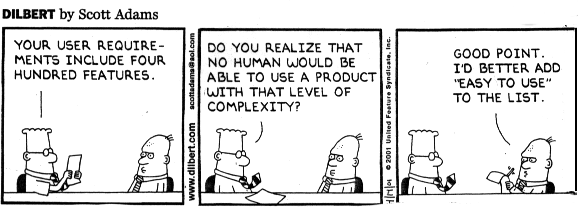Blog
sexta-feira, 7 de novembro de 2008
Good night lamp
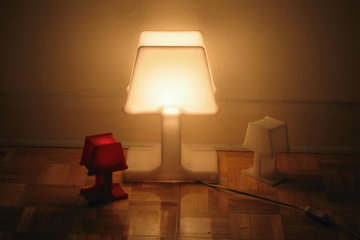
A very simple, but interesting project that promotes a sense of closeness and intimacy. Just turn on your lamp, and someone related to you will have it’s own lamp (a small version of yours) also lighted on.
The Good Night Lamp project is a family of lamps which allow people to communicate the act of coming back home to their loved ones, remotely. As you turn the bigger light on, your presence home is indicated to your friends whose smaller lamps turn on as well. Inversely, the smaller lamps that you’ve collected from your friends will turn on/off as they come home, go out, go to bed. You’ll never come back to an empty home again.
Since we seem to be more and more eager to get a sense of closeness with our loved ones (through instant messengers, twitter and alike), this looks like a very elegant and ‘calm tech’ approach to fulfill this need.
Source: http://www.goodnightlamp.com/
domingo, 26 de outubro de 2008
The end of products, the rise of services
It’s not something new to say that product design is “changing” into service design. But many people still don’t get it quite well. What do you mean? No products?
Yes. No products, at least in some specific situations. As I use to say, you don’t have to own an electric drill. You have to be able to make drill holes, no matter whose eletric drill will you use! You need the service, not the product. For many products we own, we seldon use them – the eletric drill is a classic example!
These changes are specially true when it comes to the digital world. We have seen it happening slowly, for example, with music. We had long play records, cassette tapes. They turned into CDs. And now our CDs are stored in mp3 players.
But we still have to store data in our computers, or, in the case of music, in our mp3 players. But I guess this is just a matter of time to change again. We don’t need to have the files, we need to hear the music. No matter if it is stored in our hard drives, or remotely stored in a server that can be accessed by our players. Storage is a huge problem, we have constantly to buy new storage devices to keep our stuff, as we keep producing and saving files, photos, videos…and it’s worst when you think about the backups! Burning DVDs, or copying files to external hard disks, blue rays or whatever media. I think this will change soon…I already use Dreamhost to store many of my files. I trust them to make the backups, to keep my stuff safe. I guess they have a better backup routine than me (at least, I hope they do!).
I have the feeling that this will not be only about storage. Google already have the Google Docs, with which you can edit many kinds of documents like Microsoft Word files, even if you don’t have Microsoft Word in your computer. One of the topics discussed when Adaptive Path showed their Aurora project was that the limits between the browser and an operational system were not so clear anymore. That makes sense, if you think that we don’t need to have so many programs instaled in our computers. We need to be able to perform the tasks, and that’s the idea behind Google Docs.
I recently was introduced to Lala, a not so original online music service. The new thing about it is that you don’t need to have more than 10 cents to have a “web music” added to your library, which you can stream as many times as you want. If you want to download the mp3 file, you pay more. But you don’t need to…you can just hear it with your iPhone, streaming the file. For 10 cents, not bad. Why would you want mp3 file? To have storage problems tomorrow? Just add the music to your library, and listen to it whenever you want (as long as you have a good connection!), and let them deal with the storage! Soon everything will be connected anyway…pervasive computing is at our doorstep. This way, we prevent for demanding more physical goods, and reduce the electronic waste. It seems more rational and environmental friendly.
A very interesting article about Lala is avalilable at TechCrunch.
Again, it’s not about having the product, but having the service available.
sábado, 25 de outubro de 2008
terça-feira, 21 de outubro de 2008
Presentations available in SlideShare
Busy month. I’ve been to 2 different events (P&D Design and EBAI), presenting some of the research I’ve been doing during my PhD studies.
I have much to tell about both events. But there’s also much things to catch up, to write and to read, and there’s no time to summarize my impressions properly right now.
Anyway, I just wanted to say that I’ve uploaded my presentations to SlideShare. Have fun, if you dare. ;-)
segunda-feira, 13 de outubro de 2008
Nanotechnology and Nokia Morph Concept
It has been a long time now since Nokia presented the Nokia Morph concept video, sharing their vision about how nanotechnology could be used on future communication devices.
I first saw it mentioned in IxDA discussion group. At that time I wrote my impressions about it, and today I got back to it for some reason, and I thought it would be nice to share it with those who eventually read this blog. So, quoting myself:
I was very impressed with the video. Not because of the product itself, but for the possible applications that I could imagine after seeing it. I’m not familiar with nanotechnology, but it seems to me that it is another step towards accomplishing a pervasive/ubiquitous computing world.
It seems to me that nanotechnology would make it possible to really think about embedded computers. Any sort of object could have some kind of “computer” on it. Clothes, glasses, wires…any object could became “smart”.
You may ask: is that something we would want?
I guess we already do! Just look around…
There are some key values that I see in our lives that would be enhanced with this technology.
Information is one key value. We design information systems. We design tools to make easier to find and use information. We produce information. We share information. More than ever, we consume information.
Another key component of our lives is mobility. To be able to access, to communicate, to connect with each other in different spaces is something that is vital to many of us today. Twittering on the way home. Checking emails at the airport. Taking pictures, sending them to our Flickr account in real time etc.
Still we have to deal with many devices that are not so different from our desktops computers. Laptops, iPhones…these are different sizes of a not so different conceptual product. We still have to fous very hard on the object to use it. It still demands our attention. They concentrate hundreds of functions, programs. They are more likely a swiss knife. Many tools in one device.
I guess with nanotechnology we would be able to create products that could rely on a “calm technology” approach, to quote Mark Weiser…As any object can have an “embedded computer”, being able to access information, to exchange data within the environment and within other objects, we start to have dynamic contexts of interaction. Our products could “sense” the environment, and respond to it. Change under the influence of the context. Less effort from us.
Nanotechnology is definitely not only about mobile phones. That is Nokia business, so that’s how they see it.
Nanotechnology is about wearable computers. Hands-free devices. Dynamic environments that change upon your influence.
The interaction benefits I can imagine for nanothecnology are beyond my wildest dreams. :-)
domingo, 5 de outubro de 2008
New books!
My books finally arrived!
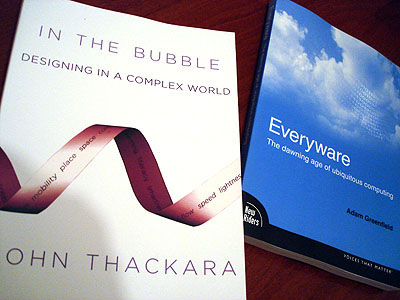
I’m almost embarrassed to say that I have never read Adam Greenfield’s Everyware before – it has been on my ‘wish list’ for ages! But I guess is still time to catch up with this “almost-classic” book about ubiquitous computing. The interesting thing about it is that it was written by a designer, so it brings users to the center of the discussion. It’s not a “techie” book about ubicomp.
And that’s also an interesting thing about Thackara’s In the Bubble. It’s more about people, not technology. It’s about how the advances in technology are affecting our lives. To quote the book:
We’re filling up the world with technology and devices, but we’ve lost sight of an important question: What is this stuff for? What value does it add to our lives?
Now, I only have to find time to read them!
sábado, 27 de setembro de 2008
Intelligent plants
If you, like me, love plants in your home but have little knowledge about how to take care of them, you may find this very interesting. I’m never sure when am I supposed to water my plants, and even when I water them, it’s hard to know how much water they need. Each plant has it’s own needs, like us. So, can be tricky to take care of them if you’re not very familiar with botanical stuff.
And there is where this smart project fits in. Using simple components, Botanicalls can make your plant gives you a phone call when it needs to be watered. It also advices you if it has too much water. To make it funnier, each plant has a unique “voice” and “personnality”, so you can really relate to each other in different ways. There is also a “Twitter” version of the system. Instead of making a phone call, the plant posts a message on Twitter. :-D
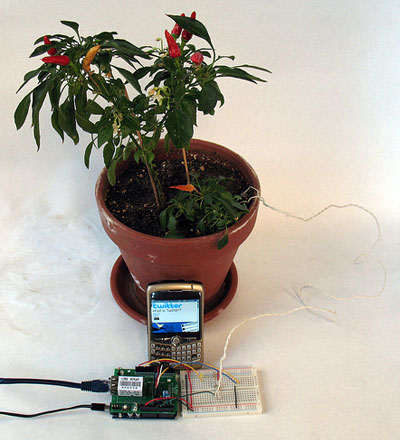
Please, give me some water!
That’s a clever use of technology. Although the initial setup to make things work is not exactly easy to do, once it’s done you might never remember that there is some “computing” going on.
UPDATE: Another “gadget” that uses the same idea, in a more simple way, is Thirsty Light. If soil is too dry, the light blinks. Different states of the light indicates different levels of dryness.
Of course, this gadget wasn’t designed to alert you by phone, like Botanicalls’ solution.
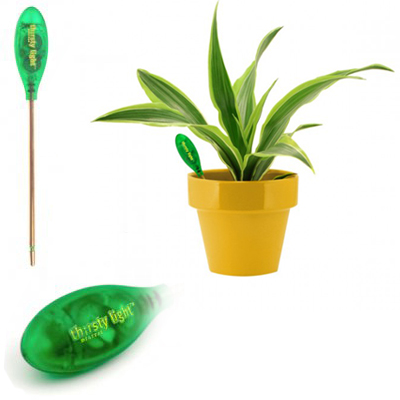
The Thirsty Light is an intuitive digital plant moisture sensor that blinks an LED to alert the user when it is time to water a potted plant. It is designed to be unobtrusive when left in the soil of a plant, where it continuosly monitors conditions, testing the moisture level once per second. (from Thirsty light website)
Calm techonology on it’s best appliance!
